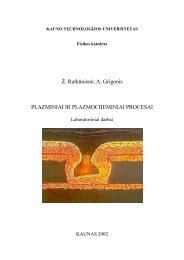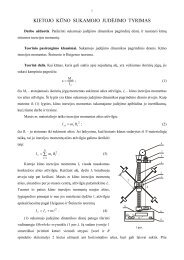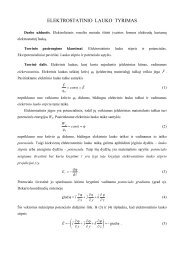PROCEEDINGS OF THE 7 INTERNATIONAL ... - Fizika
PROCEEDINGS OF THE 7 INTERNATIONAL ... - Fizika
PROCEEDINGS OF THE 7 INTERNATIONAL ... - Fizika
Create successful ePaper yourself
Turn your PDF publications into a flip-book with our unique Google optimized e-Paper software.
MEDICAL PHYSICS IN <strong>THE</strong> BALTIC STATES 7 (2009)<br />
Proceedings of International Conference “Medical Physics 2009”<br />
8 - 10 October 2009, Kaunas, Lithuania<br />
MODELING <strong>OF</strong> FIELD PARAMETERS FOR DOSE VERIFICATION IN<br />
EXTERNAL BEAM RADIO<strong>THE</strong>RAPY<br />
Arturs MEIJERS*, Sergey POPOV*<br />
* Latvian Oncology Centre, Riga Eastern Clinical University Hospital, Riga, Latvia, LV1079<br />
Abstract: In radiation therapy it is necessary to perform manual dose verification for each treatment plan. Several<br />
dosimetric parameters are dependent on treatment field size, however usually they are measured only for square fields.<br />
Therefore method allowing approximation of irregularly shaped field with equivalent square is necessary.<br />
Methods: Spreadsheet based equivalent square calculation tool based on Clarkson integration method was developed.<br />
Results: Basic verification tests suggested that by using developed method equivalent square can be determined with<br />
1.32 % error; such error would result in calculation of treatment field monitor units with 0.042 % error.<br />
Conclusions: Developed tool is easy to implement and use for manual treatment plan verifications.<br />
Keywords: equivalent square; manual dose verification<br />
1. Introduction<br />
According to international approach and<br />
recommendations, it is necessary to perform manual<br />
treatment plan verification for each patient. Manual<br />
monitor units (MU) verifications most commonly are<br />
done by using point dose calculation methods, such as<br />
isocentric method, SSD method, Clarkson’s method etc.<br />
For example, SSD method allows calculating point dose<br />
by following equation [1]:<br />
where:<br />
K – calibration index of accelerator<br />
rc – collimator field size<br />
Sc – collimator scatter factor<br />
Sp – phantom scatter factor<br />
TD – tumor dose<br />
(1)<br />
Parameters of linear accelerator (linac) are mostly<br />
dependant on beam energy, field size and depth.<br />
Parameters dependant on field size are usually acquired<br />
for square fields, however such fields are rarely used for<br />
treatment delivery. More significant are irregularly<br />
shaped fields. However, since beam parameters are<br />
acquired for square fields, it is necessary to approximate<br />
irregularly shaped fields with square field. Therefore<br />
concept of equivalent square (EQSQ) was introduced.<br />
Development of simple and easy-to-use EQSQ<br />
calculation method is significant for manual treatment<br />
plan verification. Since previously widely used dose<br />
calculation algorithms, such as pencil beam convolution<br />
56<br />
algorithm or PBC, had implemented EQSQ concept, it<br />
was possible to acquire this parameter directly from<br />
treatment planning system (TPS) reports, however<br />
analytical algorithms, such as anisotropic analytical<br />
algorithm or AAA, do not use EQSQ for dose<br />
calculation. Therefore, to perform manual plan<br />
verifications alternative EQSQ calculation method is<br />
necessary.<br />
2. Methodology<br />
EQSQ can be defined by geometric or dosimetric<br />
approach. Dosimetric approach takes into account<br />
physical characteristics of the beam, therefore it is<br />
considered more precise. Let us consider square field<br />
equivalent to irregularly shaped field if percentage<br />
depth dose (PDD) of square field at reference depth is<br />
equivalent to the PDD of irregular field.<br />
EQSQ calculation method is based on Clarkson’s<br />
integration method. However Clarkson’s method is<br />
based on use of parameters such as scatter air ratio<br />
(SAR) and tissue air ratio (TAR). Since acquisition of<br />
these parameters require additional measurements,<br />
scatter maximum ratio (SMR) and tissue maximum ratio<br />
(TMR), which are special cases of scatter phantom ratio<br />
(SPR) and tissue phantom ratio (TPR) respectively,<br />
were used instead. SMR and TMR can be calculated<br />
from depth dose (PDD) curves by method described in<br />
British Journal of Radiology, 1996, Supplement No. 25<br />
[2]. Calculation is done by using peak scatter factor<br />
(PSF).<br />
Total SMR of irregularly shaped field can be<br />
determined by following steps:








